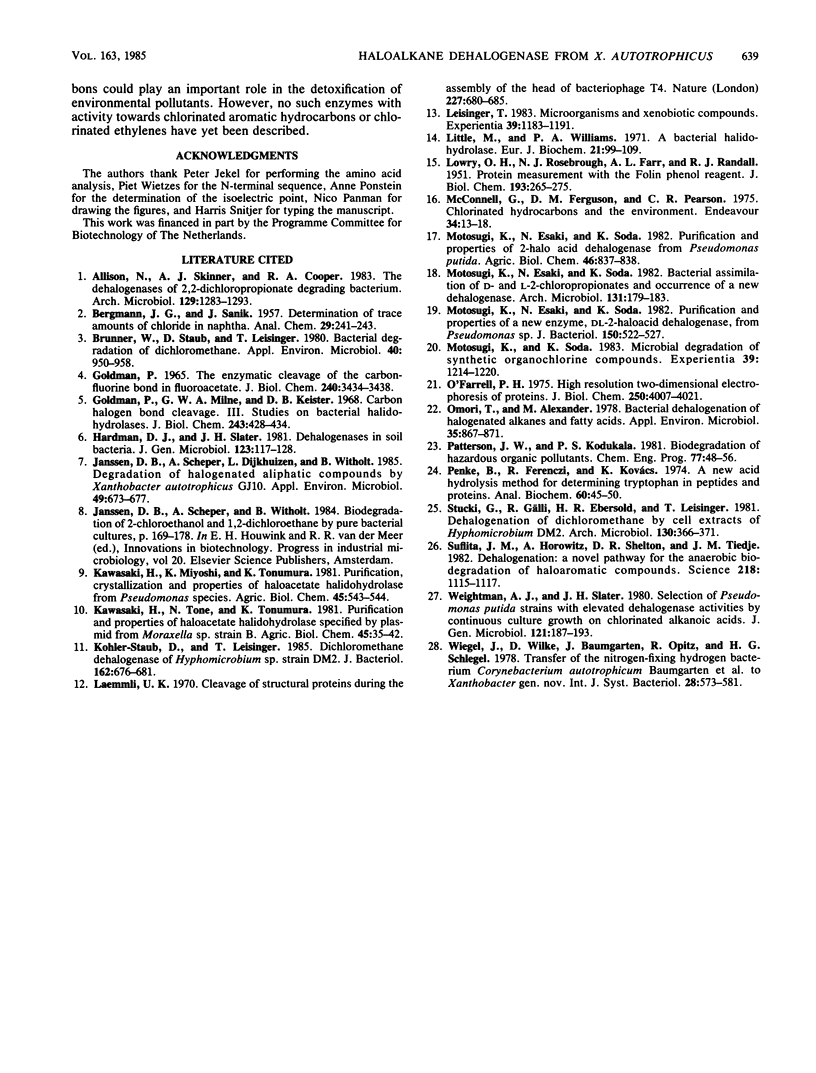Abstract
A new enzyme, haloalkane dehalogenase, was isolated from the 1,2-dichloroethane-utilizing bacterium Xanthobacter autotrophicus GJ10. The purified enzyme catalyzed the hydrolytic dehalogenation of n-halogenated C1 to C4 alkanes, including chlorinated, brominated, and iodinated compounds. The highest activity was found with 1,2-dichloroethane, 1,3-dichloropropane, and 1,2-dibromoethane. The enzyme followed Michaelis-Menten kinetics, and the Km for 1,2-dichloroethane was 1.1 mM. Maximum activity was found at pH 8.2 and 37 degrees C. Thiol reagents such as p-chloromercuribenzoate and iodoacetamide rapidly inhibited the enzyme. The protein consists of a single polypeptide chain of a molecular weight of 36,000, and its amino acid composition and N-terminal sequence are given.
Full text
PDF




Images in this article
Selected References
These references are in PubMed. This may not be the complete list of references from this article.
- Brunner W., Staub D., Leisinger T. Bacterial degradation of dichloromethane. Appl Environ Microbiol. 1980 Nov;40(5):950–958. doi: 10.1128/aem.40.5.950-958.1980. [DOI] [PMC free article] [PubMed] [Google Scholar]
- GOLDMAN P. THE ENZYMATIC CLEAVAGE OF THE CARBON-FLUORINE BOND IN FLUOROACETATE. J Biol Chem. 1965 Aug;240:3434–3438. [PubMed] [Google Scholar]
- Goldman P., Milne G. W., Keister D. B. Carbon-halogen bond cleavage. 3. Studies on bacterial halidohrolases. J Biol Chem. 1968 Jan 25;243(2):428–434. [PubMed] [Google Scholar]
- Janssen D. B., Scheper A., Dijkhuizen L., Witholt B. Degradation of halogenated aliphatic compounds by Xanthobacter autotrophicus GJ10. Appl Environ Microbiol. 1985 Mar;49(3):673–677. doi: 10.1128/aem.49.3.673-677.1985. [DOI] [PMC free article] [PubMed] [Google Scholar]
- Kohler-Staub D., Leisinger T. Dichloromethane dehalogenase of Hyphomicrobium sp. strain DM2. J Bacteriol. 1985 May;162(2):676–681. doi: 10.1128/jb.162.2.676-681.1985. [DOI] [PMC free article] [PubMed] [Google Scholar]
- LOWRY O. H., ROSEBROUGH N. J., FARR A. L., RANDALL R. J. Protein measurement with the Folin phenol reagent. J Biol Chem. 1951 Nov;193(1):265–275. [PubMed] [Google Scholar]
- Laemmli U. K. Cleavage of structural proteins during the assembly of the head of bacteriophage T4. Nature. 1970 Aug 15;227(5259):680–685. doi: 10.1038/227680a0. [DOI] [PubMed] [Google Scholar]
- Leisinger T. Microorganisms and xenobiotic compounds. Experientia. 1983 Nov 15;39(11):1183–1191. doi: 10.1007/BF01990355. [DOI] [PubMed] [Google Scholar]
- Little M., Williams P. A. A bacterial halidohydrolase. Its purification, some properties and its modification by specific amino acid reagents. Eur J Biochem. 1971 Jul 15;21(1):99–109. doi: 10.1111/j.1432-1033.1971.tb01445.x. [DOI] [PubMed] [Google Scholar]
- McConnell G., Ferguson D. M., Pearson C. R. Chlorinated hydrocarbons and the environment. Endeavour. 1975 Jan;34(121):13–18. doi: 10.1016/0160-9327(75)90062-9. [DOI] [PubMed] [Google Scholar]
- Motosugi K., Esaki N., Soda K. Bacterial assimilation of D- and L-2-chloropropionates and occurrence of a new dehalogenase. Arch Microbiol. 1982 May;131(3):179–183. doi: 10.1007/BF00405875. [DOI] [PubMed] [Google Scholar]
- Motosugi K., Esaki N., Soda K. Purification and properties of a new enzyme, DL-2-haloacid dehalogenase, from Pseudomonas sp. J Bacteriol. 1982 May;150(2):522–527. doi: 10.1128/jb.150.2.522-527.1982. [DOI] [PMC free article] [PubMed] [Google Scholar]
- Motosugi K., Soda K. Microbial degradation of synthetic organochlorine compounds. Experientia. 1983 Nov 15;39(11):1214–1220. doi: 10.1007/BF01990358. [DOI] [PubMed] [Google Scholar]
- O'Farrell P. H. High resolution two-dimensional electrophoresis of proteins. J Biol Chem. 1975 May 25;250(10):4007–4021. [PMC free article] [PubMed] [Google Scholar]
- Omori T., Alexander M. Bacterial dehalogenation of halogenated alkanes and fatty acids. Appl Environ Microbiol. 1978 May;35(5):867–871. doi: 10.1128/aem.35.5.867-871.1978. [DOI] [PMC free article] [PubMed] [Google Scholar]
- Penke B., Ferenczi R., Kovács K. A new acid hydrolysis method for determining tryptophan in peptides and proteins. Anal Biochem. 1974 Jul;60(1):45–50. doi: 10.1016/0003-2697(74)90129-8. [DOI] [PubMed] [Google Scholar]
- Suflita J. M., Horowitz A., Shelton D. R., Tiedje J. M. Dehalogenation: a novel pathway for the anaerobic biodegradation of haloaromatic compounds. Science. 1982 Dec 10;218(4577):1115–1117. doi: 10.1126/science.218.4577.1115. [DOI] [PubMed] [Google Scholar]




